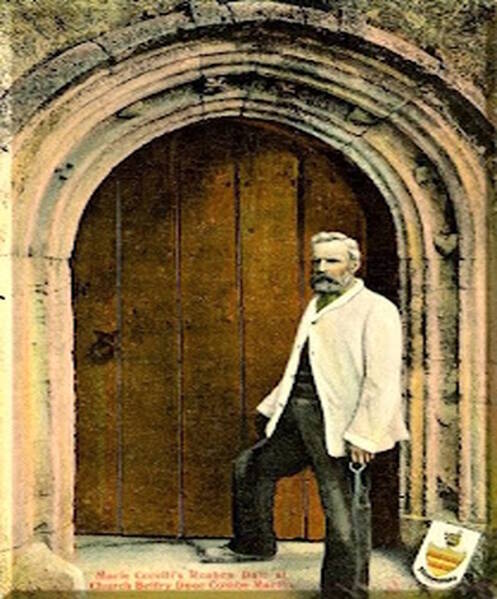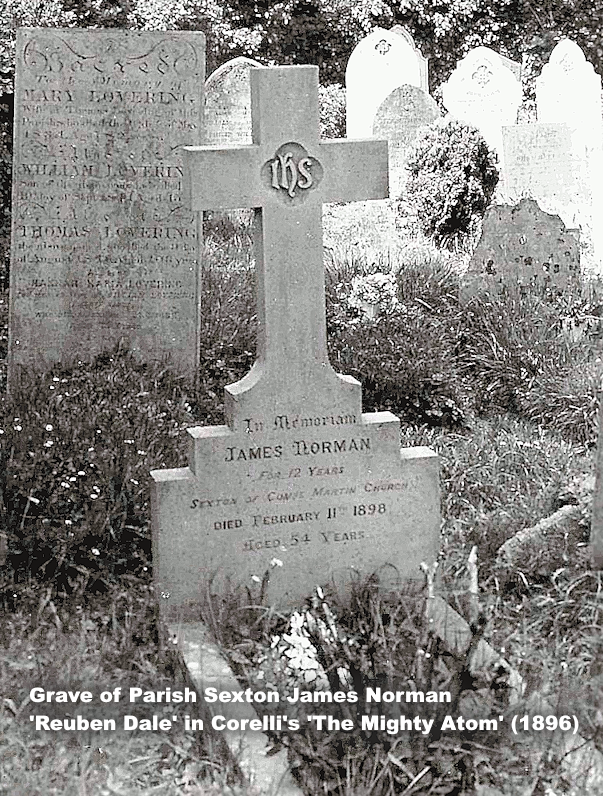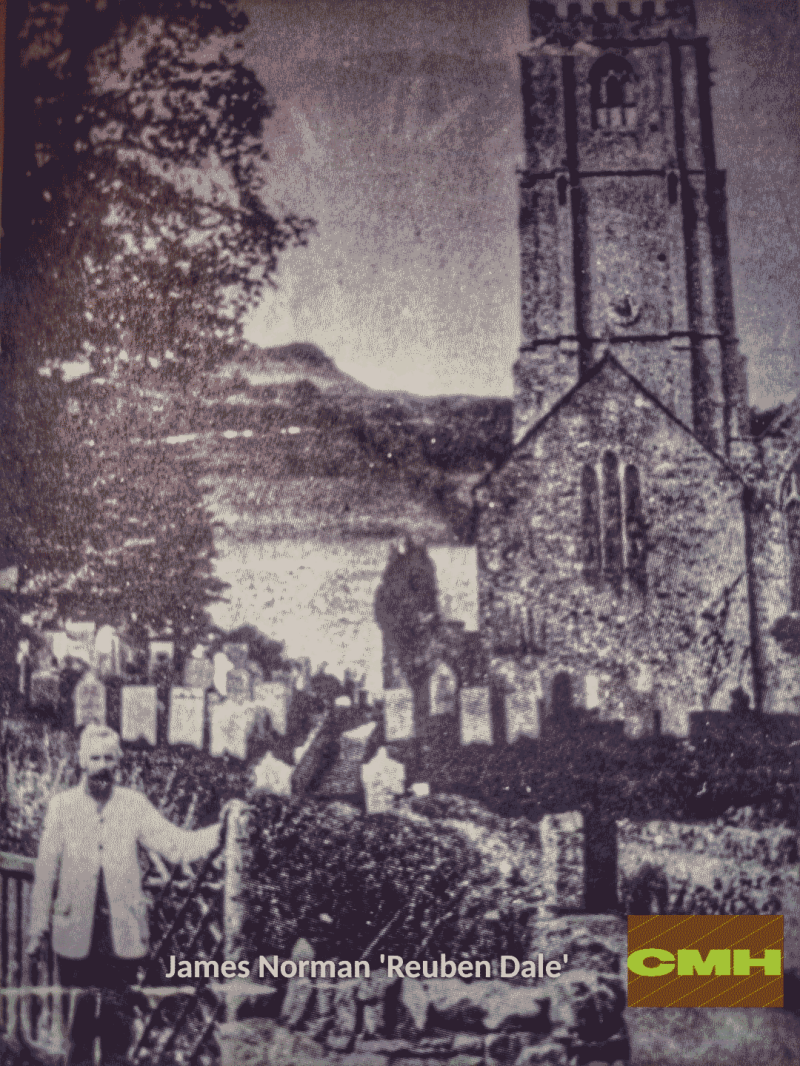James Norman ('Reuben Dale') of Combe Martin
Last Modified on February 18, 2025
Also see our other articles: Marie Corelli and James Norman | Combe Martin Parish Church
James Norman (c1844 -11.02.1898), sexton-cum-verger at St Peter ad Vincula Church Combe Martin, was the model for author Marie Corelli's character 'Reuben Dale', in her international best-selling novel The Mighty Atom (1896).
It's been said that Corelli's novel strongly advocates for spiritual beliefs. The Mighty Atom reflects several typical Victorian ideologies, particularly the tension between faith and the rise of scientific rationalism.
Corelli states in the footnotes to her novel (p. 106) that "James Norman, all unconsciously, "sat" to the author last summer for the portrait of 'Reuben Dale'."
Like everything else we do, we've conducted our own independent research into the 1890s legend of James Norman and Marie Corelli at Combe Martin.
Combe Martin Parish Church | Combe Martin Church House | Combe Martin History
The Face and Voice of Combe Martin's James Norman (d. 1898)
We've posted photographs of James Norman, and we have evidence from Corelli of how "this handsome and intelligent man" spoke:
Marie Corelli states in The Mighty Atom that "the following description of Combmartin Church came nearly verbatim from the real verger James Norman":
“[Sic] Folks ’as bin ’ere an’ said quite wise-like—‘O that roof’s quite modern,’—but ‘tain’t nuthin’ o’ th’ sort. See them oak mouldings ?—not one o’ them’s straight,—not aline. They couldn’t get ’em exact in them days—they wosn’t clever.
So they’re all crooked an’ bout as old as th’ altar screen,—mebbe older, for if ye stand ’ere jest where I be, ye’ll seg they all bend more one way than t’ other, makin’ the whole roof look lop-sided like, an’ why’s that d’ye think?
Ye can’t tell? Well, they’d a reason for what they did in them there old times, an’, sentiment too—an’ they made the churches lean a bit to the side on which our Lord’s head bent on the cross when he said ‘It is finished!’ - (James was correct).
Ye’ll find nearly all th’ old churches lean a bit like that as a sign of age, as well as a sign of faith [sic].” This extract comes verbatim from Corelli's novel, and James is bang on the money again.
Source: W. A. Henderson, Notes and Queries -1898-05-28, vol. 1 issue 22.
Combe Martin St Peter ad Vincula church is well worth exploring. Among its many secrets inside: artefacts date back to the fifteenth-century (read more˃).
Second extract quoted from The Mighty Atom by Marie Corelli (1896, p. 88)
In this passage (p. 88), Marie Corelli is actually describing James Norman (her Reuben Dale) telling the history of Combe Martin Anglican Church:
Quote: "There's an old door fur ye!" said Reuben Dale, with almost an air of triumph as he paused on the vestry threshold and rapped his ringers lightly on the thick oak panels of the ancient portal".
"That's older than anything in the church I shouldn't a bit wonder if it came out o' some sacred place o' Norman worship, it looks like it. An' here's th' old key” [to the probably medieval vestry door].
Historic England estimates the vestry plank door to be fifteenth-century, with original sanctuary ring and lock. It is similar to the door to the west tower stair turret (List Entry Number: 1106799).
Corelli wrote that Reuben "held up a quaint and heavy iron implement that looked more like a screw-driver with a cross handle than anything else".
[Referring to the old oak Peter’s Pence chest in the vestry]: "An' here's Peter's little money-box" ("showing a ponderous oak chest some five feet long and three high").
"That 'ud 'old a rare sight o' pennies, wouldn't it ! Now don't you two chillern go a-tryin' to lift the lid, for it's mortal 'eavy, an' it 'ud crush your little 'ans to pulp in a minnit. I'll let ye see the inside o't, there y'are !"
Corelli concludes: "And with a powerful effort of his sinewy arms he threw it open, disclosing its black worm-eaten interior, with a few old bits of tarnished silver lying at the bottom, the fragments of a long disused Communion-service. Lionel and Jessamine peered down at these with immense inquisitiveness". End quote.
The Evidence
Sourced from our article on Combe Martin St Peter ad Vincula Church: in 1899, author S. Baring-Gould reported "a curious double lock to the vestry door; a small key has to be turned before the lock can be made to act under the large key". The door and its odd locks can be examined today.
Several other authors refer to the 'tarnished silver Communion set' concealed in the worm-eaten 'Peter's Pence' oak chest, which used to be in the vestry. At some stage it was moved to the front of the church.
Authoritative academic historian W. G. Willis Watson (1906), biographer of The House of Martin [Lords of Combmartin], stated that "the key by which the church door is opened [was] five hundred years old, and looks its age".
The church could have been founded during the reign of the Edward I (June 1239 – 7 July 1307) or even before. The church is larger than average for a small village, owing to the silver being mined in Combe Martin. Moreover, St Peter's chancel is vaguely dated to the twelfth-century (??Henry I of England and Normandy??).
Watson implied that Lord Robert FitzMartin (c. 10?? – c. 1159) a Frankish nobleman and knight from Devon, was the first founder of Combe Martin's parish church (The History of The Martin Family &c, 1906).
Moreover, according to Allen T. Hussell F.R.I.B.A. in North Devon Churches (1909): the architectural peculiarities James Norman referred to, may not be mere faults. They might be symbolic choices made by the old builders whose craftsmanship was infused with superstitions, piety, and reverence.
Anglican churches often harbour hidden meanings, unnoticed by many. These sacred spaces serve as a visual sermon to the faithful. Within their walls, salvation, devotion, and the divine are woven into every stone.
James Norman thought that Combe Martin Church, oriented on an east-west axis, leant toward the north. According to the legend told by A. T. Hussell in North Devon Churches (1909): medieval church builders intentionally sloped churches to the north, representing Christ's head upon the Cross.
St Peter's may have been built earlier on an Anglo-Saxon site. Although some chestnut is found in ancient churches, most of the joinery that survives from the medieval period was also cut from oak, often locally-felled.
By the 12th century, nearly every Anglo-Saxon church building had been pulled down, and replaced by imposing stone structures in the northern French cruciform style.
See: The Normanisation of the English church under Archbishop Lanfranc˃
Read more about Marie Corelli and James Norman˃
James Norman's gravestone stands a few yards west of the Lych-gate at St Peter's Church.
Also see the Historic England listing #1106799 - Church of St Peter ad Vincula Combe Martin.


The Mighty Atom (1896) by Corelli, Marie (1855-1924). Philadelphia : J. B. Lippincott Company.
Corelli noted — The description of Combmartin Church in these pages is given as nearly as possible in the words of the verger, one James Norman, (may he long enjoy his cheerful, manly, and contented life!) who, all unconsciously, "sat" to the author last summer for the portrait of "Reuben Dale." This quote comes verbatim from the footnote printed in Corelli's novel The Mighty Atom, 1896, p.106.
![Combe Martin Village History [The Little Parish with a Big Story] Combe Martin Village History [The Little Parish with a Big Story]](https://primary.jwwb.nl/public/i/j/k/temp-bexcyixkrnloblaipglr/cmvhp-logo-01-june-2025-high.png?enable-io=true&enable=upscale&height=70)
![Combe Martin Village History [The Little Parish with a Big Story] Combe Martin Village History [The Little Parish with a Big Story]](https://primary.jwwb.nl/public/i/j/k/temp-bexcyixkrnloblaipglr/cmvhp-logo-01-june-2025-high.png?enable-io=true&width=100)
